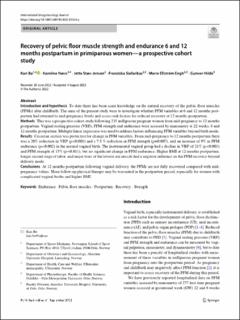| dc.contributor.author | Bø, Kari | |
| dc.contributor.author | Næss, Karoline | |
| dc.contributor.author | Stær-Jensen, Jette | |
| dc.contributor.author | Siafarikas, Franziska | |
| dc.contributor.author | Engh, Anna Marie Ellström | |
| dc.contributor.author | Hilde, Gunvor | |
| dc.date.accessioned | 2022-11-29T17:40:15Z | |
| dc.date.available | 2022-11-29T17:40:15Z | |
| dc.date.created | 2022-09-02T10:26:05Z | |
| dc.date.issued | 2022 | |
| dc.identifier.citation | International Urogynecology Journal. 2022, Artikkel 05334-y. | en_US |
| dc.identifier.issn | 0937-3462 | |
| dc.identifier.uri | https://hdl.handle.net/11250/3034852 | |
| dc.description | This article is licensed under a Creative Commons Attribution 4.0 International License, which permits use, sharing, adaptation, distribution and reproduction in any medium or format, as long as you give appropriate credit to the original author(s) and the source, provide a link to the Creative Commons licence, and indicate if changes were made. The images or other third party material in this article are included in the article's Creative Commons licence, unless indicated otherwise in a credit line to the material. If material is not included in the article's Creative Commons licence and your intended use is not permitted by statutory regulation or exceeds the permitted use, you will need to obtain permission directly from the copyright holder. | en_US |
| dc.description.abstract | Introduction and hypothesis: To date there has been scant knowledge on the natural recovery of the pelvic floor muscles (PFMs) after childbirth. The aims of the present study were to investigate whether PFM variables at 6 and 12 months postpartum had returned to mid-pregnancy levels and assess risk factors for reduced recovery at 12 months postpartum.
Methods: This was a prospective cohort study following 235 nulliparous pregnant women from mid-pregnancy to 12 months postpartum. Vaginal resting pressure (VRP), PFM strength and endurance were assessed by manometry at 22 weeks, 6 and 12 months postpartum. Multiple linear regression was used to address factors influencing PFM variables beyond birth mode.
Results: Cesarean section was protective for change in PFM variables. From mid-pregnancy to 12 months postpartum there was a 20% reduction in VRP (p<0.001) and a 7.5 % reduction in PFM strength (p=0.007), and an increase of 9% in PFM endurance (p=0.002) in the normal vaginal birth. The instrumental vaginal group had a decline in VRP of 21% (p<0.001) and PFM strength of 15% (p=0.011), but no significant change in PFM endurance. Higher BMI at 12 months postpartum, longer second stage of labor, and major tears of the levator ani muscle had a negative influence on the PFM recovery beyond delivery mode.
Conclusions: At 12 months postpartum following vaginal delivery, the PFMs are not fully recovered compared with mid-pregnancy values. More follow-up physical therapy may be warranted in the postpartum period, especially for women with complicated vaginal births and higher BMI. | en_US |
| dc.language.iso | eng | en_US |
| dc.subject | endurance | en_US |
| dc.subject | pelvic floor muscles | en_US |
| dc.subject | postpartum | en_US |
| dc.subject | recovery | en_US |
| dc.subject | strength | en_US |
| dc.title | Recovery of pelvic floor muscle strength and endurance 6 and 12 months postpartum in primiparous women: A prospective cohort study | en_US |
| dc.type | Peer reviewed | en_US |
| dc.type | Journal article | en_US |
| dc.description.version | publishedVersion | en_US |
| dc.rights.holder | © The Author(s) 2022 | en_US |
| dc.source.pagenumber | 10 | en_US |
| dc.source.journal | International Urogynecology Journal | en_US |
| dc.identifier.doi | 10.1007/s00192-022-05334-y | |
| dc.identifier.cristin | 2048192 | |
| dc.description.localcode | Institutt for idrettsmedisinske fag / Department of Sports Medicine | en_US |
| dc.source.articlenumber | 05334-y | en_US |
| cristin.ispublished | true | |
| cristin.fulltext | original | |
| cristin.qualitycode | 1 | |
